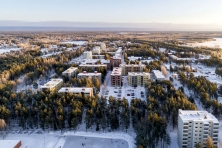Kaljama
Oulu (FI) - Winner
DONNÉES DE L’ÉQUIPE
Représentante d’équipe : Paula Manzano Salcedo (ES) – architecte
Associés: Francisco Holguín Aguilera (ES), Argimiro Macías Mojón (ES), Antonio Torres Sanz (ES) – architectes
C/ Isaac Albaniz 47 2ºA, 28222, Majadahonda, Madrid (ES)
+34 638590238 – kaljamae14@gmail.com
Voir la liste complète des portraits ici
Voir la page du site ici

A. Torres Sanz, P. Manzano Salcedo, F. Holguín Aguilera et A. Macías Mojón
INTERVIEW en anglais
Cliquer sur les images pour les agrandir
1. How did you form the team for the competition?
We knew each other from university and the four of us ended working in different fields in Madrid. Working and living in the same city gave us the opportunity to face our own common practice. After wondering many ways of doing our own work and setting our personal goals Europan seemed to be the right answer.
2. How do you define the main issue of your project, and how did you answer on this session main topic: the place of productive activities within the city?
The first goal that we worked on was the recognition of the site. In this sense, through an identification of the existing programs, built volumes and urban voids, we found the weaknesses and the areas of opportunity of the place of intervention. So in this way of understanding the problems and how to make productive a contemporary city, we took the inputs of the place specific features. We soon perceived that one of the biggest mistakes of the current urban plan is the great amount of existing carpark zones. Actually, these kind of spaces represent an obsolete city model that goes against future city concepts like hybridization and compactness. These huge carpark surfaces are not only a lost of space in terms of local economy and sustainability but an unnecessary amount of voids acting in the opposite way of urban diversity and complexity.
3. How did this issue and the questions raised by the site mutation meet?
After having done a recognisition of the site, our project understood that these carpark voids that are currently existing had to be conceived as negative spaces for the future development of the Kaijonharju – Linnanmaa district. Therefore, our main target was to change the role of these voids and transform them into creators of identity that will work as our zones of action in order to start turning this district into a productive, complex and attractive place for future inhabitants and visitors. In this way, these voids would be transformed into collaborative activities containers. They will manage those spaces that are neither public nor private that are currently not existing and will endow the district with urban unity and identity for its future development.
4. Have you treated this issue previously? What were the reference projects that inspired yours?
It was a challenge for us to work in this kind of suburban area which is inbetween the urban fabric and the wild forest. In this sense, we recognized the existing buildings, their specific programs and their own interactions in order not to build out of the established urban grid. So then we set the bases to preset and redesign the existent urban grid making it more complex through the introduction of a new group of architectures that belongs to a larger scale project. These new and anonymous architectures intensify the link between the campus, the existing housing programs and the city. Eventually, each architecture finds in its void a new public space with a specific program that gives them the quality of belonging to the site.

5. Urban-architectural projects like the ones in Europan can only be implemented together with the actors through a negotiated process and in time. How did you consider this issue in your project?
Our proposal gives a strategy that is materialized in an anonymous and a generic architecture. This is like that because, to us, the concept must prevail against the author’s architecture and it is even more the case in a negotiated process like this one. Appart from this, we also took into consideration the development, flexibility and adaptability of the project depending on the economic resources and citizenship necessities.
6. Is it the first time you have been awarded a prize at Europan? How could this help you in your professional career?
Yes, it is the first time that we have been awarded with a Europan prize and we are very pleased for this. Taking into consideration our professional careers we comprehend that this is a serious opportunity to take part into the development of this project. So understanding the complexity of this project, we are ready to assume the development of any of the phases: from the urban design to the construction phase.





